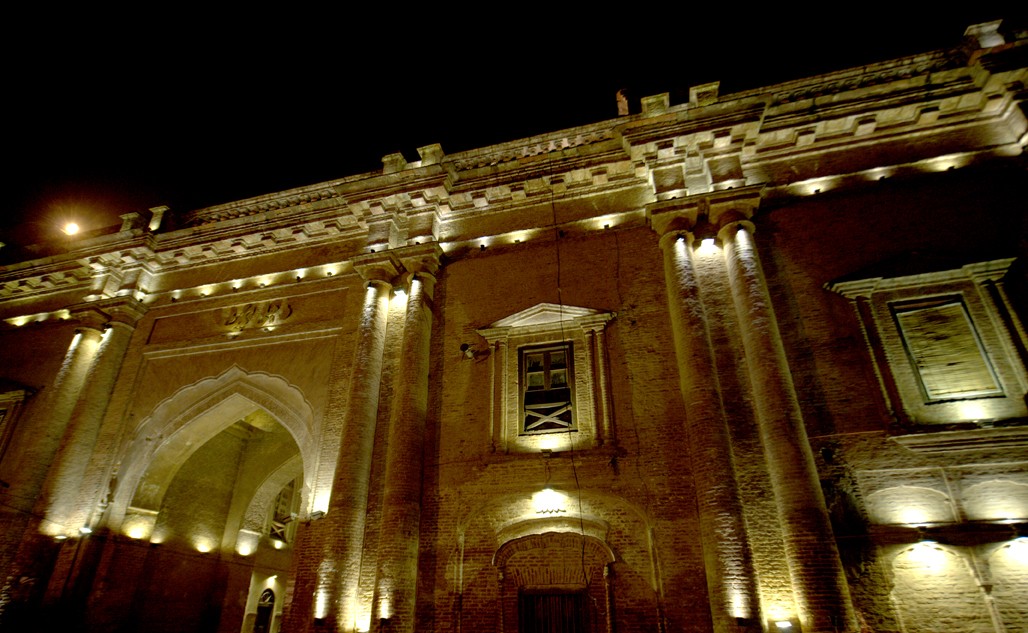
Like the other twelve historical gates of Lahore, Delhi Gate has witnessed phases of tranquility and turbulence, reconstruction and modification

Going from Lahore Railway Station towards Do Moria Pul, it takes hardly three minutes to reach the gigantic Dilli Darwaza, a huge structure welcoming you to the old city.
The Darwaza, built by the third Mughal Emperor Akbar in the 1600s, is one of the thirteen gates that provided access to the city of Lahore, once enclosed within a 30-foot high, fortified wall. Centuries later, Delhi Gate still stands majestically on the eastern side of the Walled City.
Delhi Gate was so named because it faced Delhi, the then capital of the Mughal dynasty. During the British era, all the gates of the Walled City of Lahore were demolished and the area was turned into Circular Road and a circular garden which exist to this day.
The gates were reconstructed in the early 1900s, by the British. This is one reason why the existing few gates including Delhi Gate have echoes of the Anglo-Mughal architecture.
The only Mughal gate is Roshnai Gate which is situated next to Maharaja Ranjeet Singh’s Samadhi. According to historic accounts and archival references, all the gates around the city of Lahore were built on the pattern of Roshnai. Their structures were modified when they were being rebuilt.
Delhi Gate has witnessed phases of tranquility and turbulence. There was a time when it enjoyed the status of a ‘welcoming gate’ to the "Royal City." Later, in Sikhs’ regime and during the British Raj, it served as the court of magistrate, jails and police station.
The gigantic wooden doors, still intact in Lohari Gate, were also a part of the building. But according to researchers, the doors were either burnt or damaged during riots and the War of Independence. During the Mughal era, the doors would be closed after sunset when the city traditionally went to sleep, thus allowing no access.
After 1947, the building of the gate housed a girls’ school which is still functional. Besides, the locals also use the rooftop of the Gate for holding wedding and religious ceremonies.
The ceiling of the ground-floor interior of Delhi Gate is dome shaped, with six rooms. The rooms were used by the ‘chobdars’ in Mughal era, the magistrates and the police in later times. After 1947, the rooms served as a dispensary and health centers for the local community. Presently, they are being used by the Walled City of Lahore Authority (WCLA) as a tourist information centre. Any walk-in tourist can easily get hold of a guide, as the facility is there.
One can still find pigeons resting on the bordered windows inside the Gate, a charismatic feature of Walled City buildings. Going to the rooftop one can see the recently conserved Shahi Hammam (or the Royal Bath) on the right side. It is said that when the Gate was rebuilt, a portion of the Hammam was demolished and incorporated in the Gate’s building. The existing Hammam is half of its original structure.
The rooftop of the Gate, currently a school, comprises nine rooms, a courtyard and a hall. This very hall was used by the magistrate during the British times, as the raised concrete platform is still intact. But now it is used by the teachers. The other rooms serve as classrooms and science laboratories.
The stairs, built on a 90o angle, leading to the rooftop, are another interesting feature. The reason for such a construction, as told by a tourist guide, was to reduce the climbing speed of the attacking forces. Yes, one is breathless when climbing up the stairs!
The roof is plain and even, and offers a grand view of the old city and the Royal Trail’s vibrant bazaar.
An old watchman of the school recalls wistfully how the minarets of Masjid Wazir Khan were once visible from the rooftop of Delhi Gate. Today, the view is obstructed by the many high-rise buildings that dot the cityscape.
The watchman also says that a couple of years back the entrance of the Gate was occupied by makeshift shops and stalls. The encroachments were removed as a part of the WCLA restoration project, in 2011.
Delhi Gate has another unique feature -- the Royal Trail -- which distinguishes it from the other gates of the Walled City. The Royal Trail was used by the Mughal emperors when travelling from Lahori Gate (Red Fort) in Delhi to the Lahore Fort.
The Royal Trail leads straight to Lahore Fort’s Akbari Gate, named after the Mughal Emperor Akbar. The stately monuments of the Walled City such as Shahi Hammam, Chitta Gate, Dina Nath Well, Masjid Wazir Khan, Sonehri Masjid, Pani Wala Taalab and Mariam Zamani Mosque can all be seen across the Trail.
At the main entrance of Delhi Gate, towards its left, there is a famous food market called Akbari Mandi. It is said that camels and elephants were commonly used to transport goods and food grains in the Mughal era. They have now been replaced by other beasts of burden.
The same Gate leads to the lively and rich Waan Market, Kasera Bazaar and Kashmiri Bazaar which are known for their antique crockery, traditional furniture and clothes.
Out of the thirteen gates, Delhi, Kashmiri, Sheranwala, Roshnai, Bhaati and Lohari are still seen standing magnificently around the Walled City of Lahore, but without the huge walls which once joined them. On the other hand, Masti Gate, Taxali Gate, Mori Gate, Shah Almi Gate, Mochi Gate, Akbari Gate and Yakki Gate do not exist now. Some of these gates were burnt down during the War of Independence and the others collapsed of their own.